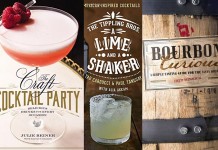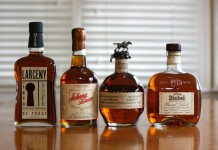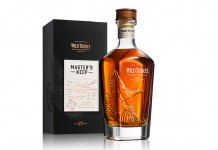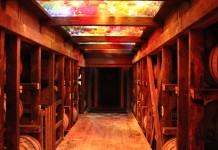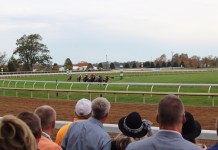
Bill Samuels, Jr. is a legend in the bourbon space. He took over Maker’s Mark from his father and helped build it into one of the most successful and beloved bourbon companies in the world. Bill did all this without ever giving in to market pressures or changes in ownership. Maker’s was one of the few one product companies in an era where most companies focused on brands and brand extensions over products. Before retiring from his post as head of Maker’s Mark, Bill Samuels, Jr. added to the Maker’s Mark legacy with Maker’s 46, a product that would expand the definition of bourbon and create even more demand for a company that still does many things by hand.
It’s two years now into Maker’s 46. What have been key learnings or takeaways from 46?
Well, you hold your breath. We did 46 because we really wanted to create something that would turn people’s heads. You never know whether you’re talking to yourself or whether you really have created a WOW experience, and I think after a year and a half, it’s pretty clear. We go to whiskey shows. We go and talk to people, and it’s 100 percent of the people that try 46 who at first can’t believe it, then they sure can’t believe it’s not full proof, and most of them after two or three days of tasting it are still waiting for the kick, and it never shows up.
Maker’s has been the leader in the whiskey category, giving consumers the idea that not all whiskey has to have bite, or kick, or be strong. Where was the genesis of that? Where did that whole philosophy come from?
It really started during the reconstruction after prohibition when Dad wanted to start over. They had to rebuild the distillery and to start over. They had plenty of time. That was the good time to try to take the bite out of the product and actually create a bourbon that tasted good. My grandfather was hearing none of it. So, that was put on hold until after prohibition. After the Second World War, Dad retired. He was driving Mom crazy hanging around the house and she said, “Go get a job.” He didn’t want a job. She said, “Why don’t you go buy one of these failing distilleries?” because they were falling down about one a week. It was a bad, bad time for bourbon. It was really the end of bourbon. It was insight, kind of like the buggy whip factory, and he went and bought this little place for $35,000. I was with him when he went to the courthouse. He started experimenting, trying to create a bourbon that actually tasted good, and that translated to him that all of the taste profile needed to be in in the front half of the tongue, and the farther forward, the better.
There’s no bitterness forward so that was what he started out with as an objective. All of his friends happened to be people that owned distilleries, and they all loved each other and they helped him. You never hear something like that today. They really helped him create that very distinctive taste of Maker’s Mark. It was a lot of fun – me as a kid riding around with him on the weekends to go see Pappy, and Jerry Beam, and Lem Motlow‘s son down at Jack Daniels. I just thought all the titans of various industries had that same relationship with each other. Little did I know that Coke and Pepsi don’t operate that way.
There’s the famous story of your dad “burning” the family recipe.
That was right in this room when it was a barrel room. It was a big deal, because we owned and operated distilleries here in Kentucky since the mid 1780s, and here it was in 1954, 170 years since we started. Dad was the sixth generation to own and operate a bourbon distillery in Kentucky, but he was the first to say, “Hey, I wonder if we can make it better by changing how we do it.”
That very first day, that very first batch that we made, he invited all his friends plus all of the distillers that helped him create that taste. It was the only day of middle school I missed. I’m down here, my sisters are here, both of them younger – the younger one was about seven. Dad took this bucket right here, which we now use as garbage can, an old yeast bucket, and took his family’s whiskey recipe, wrinkled it up, put it down in, added some more papers, put some lighter fluid in, and lit it on fire. I thought he was lighting it on fire, and because of the fact that it has a constricted opening, it actually created a rocket nozzle. Just as he dropped that match in, my sister looked over to see what was going on, and it caught her hair on fire. That was our first and last family ceremony. But she survived, and fortunately she didn’t get her eyes in the way, but it did singe her hair.
Maker’s has been in business producing since the 50s. How much different is what’s going on now in Maker’s Mark from the early days?
Well, it’s a balancing act. We have a rule here: no compromise. We don’t compromise the product even if we desire to make more and even if there’s more customers wanting to buy more. We have a responsibility to the US Department of Interior because this was the first beverage facility in the United States designated a national historic landmark. We have a responsibility preserving the old Victorian village. We have a responsibility to be commercially sensible, which means growth, controlled growth, and managed growth is okay as long as the product doesn’t suffer along the way. That has really been my life’s work. Mom and Dad created the product and my job once it started to catch on was not screw it up. My job description when I came in was to go find customers. My son’s, when he came in and took over about eight month ago, was don’t screw it up.
It seems like in the whiskey market, there’s an increasing pressure to put out not just a product but a line of products, and kind of hit every whim that a whiskey customer can have from flavorings to different mashbuilds and such. How do you navigate through those waters?
Well, it’s not how we navigate through. I never believed in it. I mean I thought it was just people throwing garbage against the wall and see what happened, and that’s not exactly true. It’s just that I’ve never been in an environment where it was successfully done.
In the last couple of years, we’ve had the pleasure of working along beside a guy named Bill Newlands who is the US President of Jim Beam, and he is a natural. He can pick ’em. I just love to talk to him. He’s the first person that I’ve ever seen that has an instinct for what customers want, and fortunately he agrees with us that we need to stick to our knitting, and we do. We got plenty of work to do to develop, and develop properly, 46 which is a very difficult product to make consistently. We’ve had our hands full. Maker’s continue just to grow at double digits and we are in our 34th year. Forty-six has exploded, scares us to death, so the last thing we need are other little distractions taking away from the inventory we have. Every drop of Maker’s is made down here in Loretto, and anything we would do to utilize some of that inventory for another product, we would take away for what’s available for a product that’s already in greater demand than we have supply. It would be like committing suicide to get too invested in that stuff. I will say if I die tomorrow, I will have seen at least one person that had a nose for what to do next. I could list off the stuff, and I will tell you, I thought almost all of Bill Newlands’ ideas were crazy and damn near every one of them worked. So, it has been a great education for me. None of them applied to us but they certainly applied to building a large, successful, diverse spirits company.
So what has it been like turning the reigns over to your son, Rob?
It has been fun. I knew ahead of time it was going to work because we’re great believers in personality testing and the role of an operating style in shaping wins and losses. I’ve also seen a lot of family companies where the entrepreneur who’s usually a guerilla, and that would be me, would turn the business over to the first son who’s totally unadapted to such pressures and just doesn’t have the confidence or the imagination to do it. In Rob’s case, it’s there in spades. So it’s just going to get better.
What do you think the biggest challenge ahead is for Rob with Maker’s Mark?
Oh, there’s no question about it. It’s carefully managing a very limited inventory when demand continues to soar way above our ability to supply. It looks like Maker’s has hit the tipping point and the snowball is starting to roll on its own without – all the time I was here, it was always work and I retired just when it started downhill. And I think that’s tougher because there’s a tendency to get complacent and arrogant and next thing you know, you got a mess on your hands. But I don’t believe that will happen with Rob.
One of the things that’s clear about Maker’s Mark is that you have a family business that does things still in a very artisan, small batch way, and yet you’re one of the major brands in the bourbon space. How have you been able to maintain the kinds of things that get obliterated when people think about success or mass production?
Well, for the first 24 years with our association with an international spirits company, it wasn’t quite so tough because we weren’t on the radar screen, plus the fact that none of them had US operations. There weren’t any opportunities to screw it up. Now with Beam, how we’re able to do it is thanks to the wisdom of a guy named Matt Shattock who is the president – he has got the authority to do anything he wants to and he’s more of a guardian maniac than either Rob or I. He’s just brilliant and I don’t know why other companies haven’t been able to nurture two cultures within one company.
Many American companies look overseas for their work, but Maker’s is a definitive American company with everything done right here in Kentucky.
Well, so is Beam. We’re the two oldest of the distillers, Colonel Beam’s great-grandfather and my fore great-grandfather. The two of us have the longest lineage of any bourbon makers in the world. I still think that there would be opportunities to cheat or conserve especially when we’re so close to each other, if it weren’t for the wise leadership of Matt Shattock, who by the way is an Englishman, not a US citizen. He’s very, very sharp and we love working with the guys at Beam, but I’m telling you, they’re two very different cultures. We help each other all the time. They’ve got technical staffs over there that rescue us almost on a daily basis.
People have a perception, when they see a bottle with Maker’s on the bar with a major company behind it, but the reality, in terms of how you produce things, there’s a much more ragtag aspect to it.
Yes, there is.
How do you keep sane when you have power going out and boilers going over…
Everything gets stressed. It’s just the way it is. You get people that are fast on their feet and are used to taking responsibility. Victoria, our plant manager down here, is not a micro manager so everybody is responsible for quality. Everybody is responsible for keeping the trains on time. There is constant pressure to get orders out, to make sure that the distillery is not ever shut down because those are commitments that we make six years ahead.
Most people don’t realize that you have a special connection with the Jack Daniel’s legacy . You’ve talked a little bit about you going to Vanderbilt. What was your experience like going to school right across from the Jack Daniel’s distillery?
Well, it wasn’t a distillery. It was the office. It was a corporate office there in Nashville. The back door of the law school let right into the front door of the Jack Daniel’s offices. The Motlows had always been big supporters of Vanderbilt Athletics, which needed all the help they could get. It was just an association because the Motlow families and my father were very good friends. I really learned the business from Hap Motlow, who was Lem Motlow’s son. He was the chairman and very gracious to give me so much time. It was three years every Friday afternoon and I wouldn’t trade it for anything. Plus the fact they’re now owned by Brown-Forman, and there’s nobody that I respect as much as I do the Brown family. I have had the good fortune to know all of them and know them well. So we’ve touched Jack Daniel’s all the way around and anytime somebody starts talking about it, I get my boxing gloves up because I just think so much of him.
What was the biggest thing you learned from Hap?
The biggest thing I learned from Hap was passion for the business and respect for each other. He was as maniacal as my father was about how we all hang together, because I got to actually practice it with. I got to go around and visit with the other distillers and also got to witness the incredible contribution the Motlow family made to Vanderbilt. So I made that part of my life’s work. I’ve chaired a number of university boards and now I’m chairman of the university’s capital campaign, all that directly a result of Hap.
Now you said that even though you retired, you’re working – you’re still clocking in how many hours?
Well, I’m generally the first one in the office in the morning because I got to do a little work, and on the weekends. Today is Monday. I was in Saturday and Sunday which is normal but maybe not from a retired person but the pressures at the business is not really there. Rob takes care of the wars and I just sneak in behind and help him when I can, whenever he asks. I’m very busy in the community which I enjoy. So I don’t ever get home before 6:00 so my wife is okay.
What’s your favorite thing about having been involved with Maker’s Mark and building it to what it is today? Is there something that you will always cherish?
Oh, there’s an enormous satisfaction and it’s not something you need to see up on the billboard. It’s an internal thing. How many people get to quarterback the development of one of the great brands of the world? Now, I didn’t create it. Mom and Dad did all that. They did the heavy lifting, as my father used to remind me in my early days, but we kept from screwing it up and that’s worth something. It’s also a great satisfaction watching my son take it up and him knowing the industry as well as he does, having been with us for five and a half years before he took it. Even though he’s young, he’s 37.
So before he took it up, he was there almost as long as it takes for the whiskey to get ready to be put in the bottle. He matured almost at the same rate as the whiskey.
A little bit faster, not much.
One of the things you’re leaving behind as a legacy is Maker’s 46.
Yeah, that’s my baby.
It’s a product that expands the whiskey category. When you were starting to look at creating that product, were you looking at doing something different for whiskey?
Basically I had two criteria. The last thing we wanted to do was to get into the “me too” race of brand expressions. I got to tell you, from where I sit as a red-blooded distiller, that’s a pretty irrelevant, trendy kind of nonsense. If it creates great taste, great. If it’s just selling a twist on a process and procedure, it starts to sound more like marketing gibberish.
Kevin Smith, our master distiller, and I sat down and we said, if we cleared our heads of all of our vices against doing anything and said okay, we’re going to create a legacy for me so I’ve got something to put on my tombstone other than “he didn’t screw it up”, what would we do? And how high would we want the bar? And so we really settled on, if we’re going to do it, it ought to have implications for expanding the scope of bourbon, and do it naturally and honestly. How can we provide an avenue of taste difference that is bourbon and creates a “wow?” And clearly the biggest obstacle, the yin and the yang of bourbon, is big taste, long finish, and comes with a kick. It’s the nature of the beast. It’s part of the beast. We said, “What if we could do that and not have the kick? Not have that bitter aftertaste?” So that’s what we set out to do,and I don’t think we had ever gotten there if we wouldn’t have that as very specific objective.
10, 15, 20 years from now, where do you think Maker’s Mark will be and what will it look like?
That’s a great question. I don’t know. I think I can say without question that we’re going to spend the next two years managing a limited supply. I’m almost positive of that unless Europe blows up and we follow right behind them. But if the economy doesn’t blow, I think the next 10 years, we’re going to have significantly less product than we’ve got demand. I see us staying true to our values. I see us being honest about what we’ve got, about not shopping for supplies somewhere else and sticking it in the Maker’s Mark bottle, and all of those temptations. After 10 years, I don’t know. I think a lot of it might depend on the bourbon trend. Unlike a lot of other trends, bourbon is more rooted in authenticity and reality, and it probably ought to sustain those of us that are interested in the Kentucky economy. I certainly hope so. But it might wane. You got to remember, the last time bourbon was really popular was 1918. It never really recouped after prohibition. So it took 90 years to swing into the trough and come back up and become fashionable again, and I would suggest that what Mom and Dad did in creating the first real premium bourbon had a hell of a lot to do with the fact that all distillers are basking in the success and we’re doing it all together. Everybody has got really distinct, interesting products and nobody has to apologize for anybody and there is a great feeling in that. But Mom and Dad got it started.
Your mom is often cited as kind of the brain trust for a lot of the things that have ultimately defined Maker’s Mark.
We have a barometer because she and Dad went through school together. He gets an awful lot of credit – I always felt like he got more than he deserved – but just if you look at their academic records, she finished first at University of Louisville in 1932 and Dad finished last. So you know how that goes: smart people usually end up getting a little bit more done than the dummies.
What do you think is the biggest gift your mom gave to both Maker’s Mark and the whiskey space?
Well, I always say Dad really had the primary role, with a lot of help from folks, in creating bourbon that tasted good. So he brought the taste good to bourbon, front palate, and she brought good taste.
Maker’s Mark is located in Loretto, Kentucky and is open to the pubic. They receive over 100,000 visitors a year and are currently rebuilding their visitor center to accommodate an expected 150,000 people in 2012.
Be sure to read our expanded look at Maker’s Mark in: The Story of Maker’s Mark.







